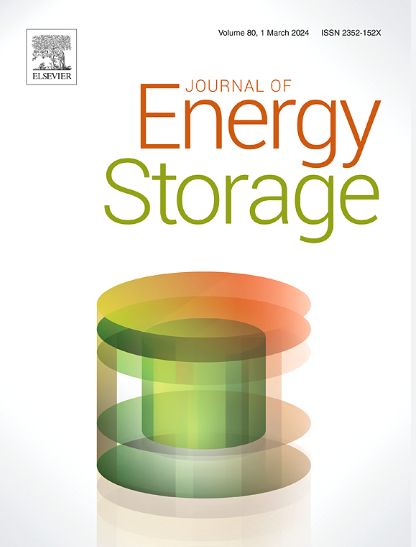采用相变材料的创新泡沫混凝土增强建筑物的室内热舒适性
IF 8.9
2区 工程技术
Q1 ENERGY & FUELS
引用次数: 0
摘要
能源消耗可以通过改善建筑物的热性能和有效利用能源来减少。这可以通过将具有储热性能的相变材料(PCM)集成到建筑围护结构的泡沫混凝土中来实现。本研究旨在制备硅藻土/癸酸(CA)复合材料,并将其融入泡沫混凝土结构中,提高建筑在真实天气条件下的热能性能。为此,首先通过直接浸渍确定硅藻土对癸酸的吸收率最高可达50%(重量计)而不泄漏。将制备的硅藻土/CA复合材料以15%、20%、25%和30%的比例替代砂骨料加入泡沫混凝土中。硅藻土/CA复合材料的熔化温度和冻结焓值分别为28.73℃和28.49℃,分别为101 J/g和193 J/g。随着硅藻土/CA比的增大,铺展直径和干单位重值减小,吸水率和表观孔隙率值增大。导热系数和抗压强度随硅藻土/CA用量的增加而降低。当硅藻土/CA含量为30%时,泡沫混凝土的最高吸水率为25.9%,表观孔隙率为34%,抗压强度为6.31 MPa。导热系数在0.495 ~ 0.241 W/mK之间变化。温度调节测试结果表明,含有30%硅藻土/CA的泡沫混凝土板显著改善了室内温度调节,在高温高峰期达到约3.7°C的冷却效果,并通过将室内温度保持在8.8°C以上,有助于减少夜间的热负荷。本文章由计算机程序翻译,如有差异,请以英文原文为准。
Enhancing indoor thermal comfort in buildings using innovative foam concrete with phase change material
Energy consumption can be reduced by improving thermal performance of buildings and using energy efficiently. This can be achieved by integrating phase change material (PCM) with heat storage properties into foam concretes in building envelopes. The present study aims to prepare diatomite/capric acid (CA) composite, integrate it into foam concrete structure and enhance thermal energy performance of buildings under real weather conditions. For this purpose, it was first determined that diatomite could absorb capric acid at a maximum of 50 % (by weight) without leakage by direct impregnation. The prepared diatomite/CA composite was incorporated to foam concrete mixture as a substitute for sand aggregate at four different ratios of 15 %, 20 %, 25 % and 30 %. For diatomite/CA composite, melting and freezing temperatures and enthalpy values were found to be 28.73 °C and 28.49 °C, and 101 J/g and 193 J/g, respectively. While spreading diameter and dry unit weight values decreased as the ratio of diatomite/CA rose, water absorption and apparent porosity values increased. Thermal conductivity and compressive strength decreased depending on the increase in amount of diatomite/CA. For foam concrete with 30 % diatomite/CA, the highest water absorption, apparent porosity and compressive strength were measured as 25.9 %, 34 % and 6.31 MPa, respectively. Thermal conductivity varied between 0.495 and 0.241 W/mK. Thermoregulation test results demonstrated that foam concrete slabs containing 30 % diatomite/CA significantly improved indoor temperature regulation, achieving a cooling effect of approximately 3.7 °C during peak heat periods and contributing to a heating load reduction at night by maintaining indoor temperatures up to 8.8 °C warmer.
求助全文
通过发布文献求助,成功后即可免费获取论文全文。
去求助
来源期刊

Journal of energy storage
Energy-Renewable Energy, Sustainability and the Environment
CiteScore
11.80
自引率
24.50%
发文量
2262
审稿时长
69 days
期刊介绍:
Journal of energy storage focusses on all aspects of energy storage, in particular systems integration, electric grid integration, modelling and analysis, novel energy storage technologies, sizing and management strategies, business models for operation of storage systems and energy storage developments worldwide.
 求助内容:
求助内容: 应助结果提醒方式:
应助结果提醒方式:


